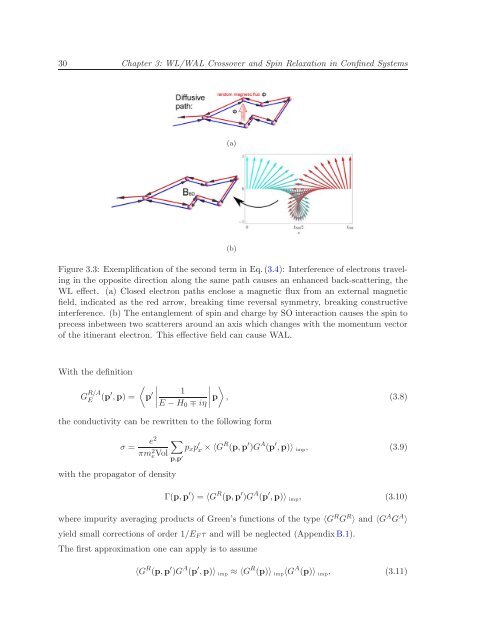Itinerant Spin Dynamics in Structures of ... - Jacobs University
Itinerant Spin Dynamics in Structures of ... - Jacobs University
Itinerant Spin Dynamics in Structures of ... - Jacobs University
You also want an ePaper? Increase the reach of your titles
YUMPU automatically turns print PDFs into web optimized ePapers that Google loves.
30 Chapter 3: WL/WAL Crossover and <strong>Sp<strong>in</strong></strong> Relaxation <strong>in</strong> Conf<strong>in</strong>ed Systems<br />
(a)<br />
(b)<br />
Figure 3.3: Exemplification <strong>of</strong> the second term <strong>in</strong> Eq.(3.4): Interference <strong>of</strong> electrons travel<strong>in</strong>g<br />
<strong>in</strong> the opposite direction along the same path causes an enhanced back-scatter<strong>in</strong>g, the<br />
WL effect. (a) Closed electron paths enclose a magnetic flux from an external magnetic<br />
field, <strong>in</strong>dicated as the red arrow, break<strong>in</strong>g time reversal symmetry, break<strong>in</strong>g constructive<br />
<strong>in</strong>terference. (b) The entanglement <strong>of</strong> sp<strong>in</strong> and charge by SO <strong>in</strong>teraction causes the sp<strong>in</strong> to<br />
precess <strong>in</strong>between two scatterers around an axis which changes with the momentum vector<br />
<strong>of</strong> the it<strong>in</strong>erant electron. This effective field can cause WAL.<br />
With the def<strong>in</strong>ition<br />
G R/A<br />
E (p′ ,p) =<br />
〈 ∣ ∣∣∣<br />
p ′ 1<br />
E −H 0 ∓iη<br />
the conductivity can be rewritten to the follow<strong>in</strong>g form<br />
σ =<br />
with the propagator <strong>of</strong> density<br />
〉<br />
∣ p , (3.8)<br />
e 2 ∑<br />
πm 2 p x p ′ x<br />
eVol<br />
×〈GR (p,p ′ )G A (p ′ ,p)〉 imp , (3.9)<br />
p,p ′<br />
Γ(p,p ′ ) = 〈G R (p,p ′ )G A (p ′ ,p)〉 imp , (3.10)<br />
where impurity averag<strong>in</strong>g products <strong>of</strong> Green’s functions <strong>of</strong> the type 〈G R G R 〉 and 〈G A G A 〉<br />
yield small corrections <strong>of</strong> order 1/E F τ and will be neglected (AppendixB.1).<br />
The first approximation one can apply is to assume<br />
〈G R (p,p ′ )G A (p ′ ,p)〉 imp ≈ 〈G R (p)〉 imp 〈G A (p)〉 imp , (3.11)
















